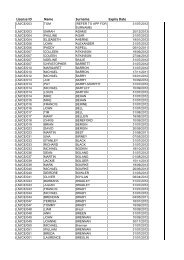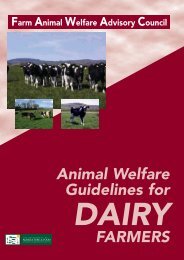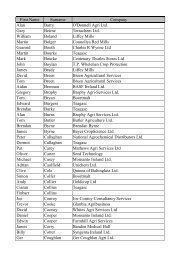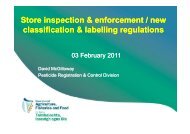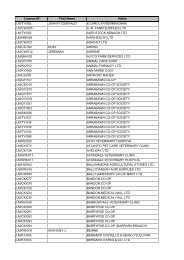Dr. Aidan Moody presentation - iasis.ie
Dr. Aidan Moody presentation - iasis.ie
Dr. Aidan Moody presentation - iasis.ie
Create successful ePaper yourself
Turn your PDF publications into a flip-book with our unique Google optimized e-Paper software.
IASIS Conference<br />
Killenard, 3 February 2011<br />
Pesticides and Water<br />
Exposure Assessment, Monitoring & Controls<br />
<strong>Aidan</strong> <strong>Moody</strong><br />
Pesticide Registration & Control Division
Contents<br />
• Introduction<br />
• Groundwater exposure assessment<br />
• Surface water exposure assessment<br />
• Water Framework Directive<br />
• Di <strong>Dr</strong>inking water monitoring<br />
i<br />
• Minimising exposure<br />
• Conclusions
Introduction<br />
Exposure assessment requirements<br />
Environmental Sc<strong>ie</strong>nce Unit<br />
Environmental Fate<br />
Ecotoxicology<br />
Predicted Environmental Concentration (PEC)<br />
• Groundwater<br />
• Surface water (and sediment)<br />
• Directive 91/414/EEC (S.I. No. 83 of 2003)<br />
• Regulation (EC) No 1107/2009
Groundwater<br />
• Groundwater is an important source of drinking<br />
water.<br />
• Provides ~9% of Irish drinking water<br />
(over 80% in Roscommon).<br />
• For pesticide approval, PEC in groundwater must<br />
not exceed 0.1 microgram/L.
Groundwater<br />
• 0.1 microgram/L = 0.1 ppb<br />
(1 part in 10 billion)<br />
• Equivalent to one drop in an Olympic-sized<br />
swimming pool!<br />
(1 stem in 111,000 hay bales, 1 baked bean in 21<br />
million cans)<br />
• Not a health-based standard<br />
(Political decision from 1980 to use 0.1 ppb as a<br />
surrogate for zero.)
Groundwater<br />
• EU leaching models used to calculate PEC in<br />
groundwater (diffuse pollution).<br />
• Models use Good Agricultural Practice (GAP) for<br />
pesticide product, chemical propert<strong>ie</strong>s of active<br />
ingred<strong>ie</strong>nt, and EU-defined leaching scenarios.<br />
• Scenarios are combinations of –<br />
weather data<br />
soil propert<strong>ie</strong>s<br />
crop information.<br />
• Aim is to calculate realistic worst-case PEC<br />
(at 1 m depth below the soil surface).
Groundwater<br />
Leaching – downward movement of pesticides in water through soil
Surface water<br />
• Assess exposure in edge-of-f<strong>ie</strong>ld water bod<strong>ie</strong>s:<br />
ditches, streams, ponds.<br />
• PEC in surface water and sediment must not be<br />
harmful to aquatic life forms.<br />
• Aquatic risk assessment performed.<br />
Risk = Adverse-effect level/PEC<br />
Margin of safety must be acceptably high.<br />
• Aim is to protect ecology of water bod<strong>ie</strong>s<br />
(sc<strong>ie</strong>nce-based protection goal).
Surface water<br />
• EU aquatic exposure models used to<br />
calculate PEC in surface water and<br />
sediment (diffuse pollution).<br />
• Models use –<br />
GAP for pesticide product<br />
chemical propert<strong>ie</strong>s of active ingred<strong>ie</strong>nt<br />
EU-defined aquatic exposure scenarios.<br />
• Aim is to calculate realistic worst-case PEC.
Surface water<br />
Key entry routes: spray drift, drainage, runoff
Surface water<br />
• <strong>Dr</strong>ainage<br />
Removal of surplus water from land to surface water by the<br />
use of within-f<strong>ie</strong>ld drains.<br />
• Runoff<br />
Transport of water and sediment from the surface of an<br />
agricultural f<strong>ie</strong>ld, by overland flow, to a non-target area<br />
such as a stream, due to a precipitation event.<br />
• Spray drift<br />
Downwind movement of airborne spray droplets beyond<br />
the intended area of application, originating from spraying<br />
operations.
Buffer zones<br />
Surface water<br />
Outcome of assessment may require a buffer<br />
zone (untreated area) to reduce spray drift<br />
and/or runoff input (e.g. 5 m grassed strip).
WFD<br />
Water Framework Directive (Directive 2000/60/EC)<br />
• Prevent deterioration in the status of surface<br />
waters, groundwater bod<strong>ie</strong>s, estuar<strong>ie</strong>s and<br />
coastal waters.<br />
• Aim to ach<strong>ie</strong>ve good status in WFD water bod<strong>ie</strong>s<br />
by 2015.<br />
• Catchment-based approach<br />
River Basin Districts<br />
(instead of edge-of-f<strong>ie</strong>ld)<br />
f<strong>ie</strong>ld)<br />
• Rivers and lakes<br />
(rather than ditches, streams and<br />
ponds)
WFD<br />
Irish River Basin Districts (RBDs)<br />
8 RBDs Authorit<strong>ie</strong>s<br />
Neagh Bann IRBD<br />
North Western IRBD<br />
Shannon IRBD<br />
North Eastern RBD<br />
Eastern RBD<br />
South Eastern RBD<br />
South Western RBD<br />
Western RBD<br />
Monaghan / DOE NI - NIEA<br />
Donegal / DOE NI - NIEA<br />
Limerick<br />
DOE NI - NIEA<br />
Dublin City<br />
Carlow<br />
Cork<br />
Galway
WFD<br />
Lead agenc<strong>ie</strong>s in Ireland<br />
• DEHLG<br />
• EPA<br />
• Local authorit<strong>ie</strong>s<br />
Other government departments and agenc<strong>ie</strong>s involved<br />
(DAFF, DETI, Central Fisher<strong>ie</strong>s Board, Teagasc,<br />
Waterways Ireland etc.)<br />
See www.wfdireland.<strong>ie</strong> for more info.
WFD<br />
Two main areas of concern for pesticides<br />
• River Basin Management Plans<br />
(controls on pesticide use)<br />
• Monitoring programmes<br />
(compliance with EQS values)
River Basin Management Plans (RBMPs)<br />
Measures for pesticides include –<br />
• GAP (Good Agricultural Practice)<br />
• Sustainable Use National Action Plans<br />
• Supplementary measures for forestry<br />
(reduce usage, pre-dip plants, develop<br />
biological controls)<br />
Future measures could include<br />
restricting/prohibiting pesticide use in<br />
designated areas if there is a problem.<br />
WFD<br />
WFD could impact on regulatory status of pesticides.
Sustainable Use Directive – 2009/128/EC<br />
WFD<br />
• Reduce risks and impacts of pesticide use on human<br />
health and the environment.<br />
• Focus on protection of aquatic environment and<br />
drinking water suppl<strong>ie</strong>s.<br />
• Measures to protect aquatic environment and drinking<br />
water suppl<strong>ie</strong>s must be compatible with the WFD.<br />
• Possible mitigation measures for National Action Plan –<br />
buffer zones (aquatic environment)<br />
safeguard zones (drinking water abstraction points).<br />
SU NAP ill b th i t<br />
SU NAP will be the main measure to<br />
deliver WFD pesticide-related objectives.
WFD monitoring<br />
• National programme covering surface waters and<br />
groundwater.<br />
• Administered by EPA.<br />
• Results will be made available on EPA website –<br />
www.epa.<strong>ie</strong>/whatwedo/wfd/monitoring/results<br />
WFD<br />
• Groundwater monitored at 145 sites for –<br />
2,4-D, atrazine, bentazone, chlorotoluron,<br />
cypermethrin, DDT, d<strong>ie</strong>ldrin, diuron, glyphosate,<br />
isoproturon, lindane, MCPA, mecoprop and simazine.<br />
• Groundwater results compared against threshold<br />
level of 0.1 microgram/L.
WFD<br />
WFD surface water monitoring<br />
• EU-specif<strong>ie</strong>d substances and additional national substances.<br />
• EU-specif<strong>ie</strong>d pesticides –<br />
alachlor, aldrin, atrazine, chlorfenvinphos, chlorpyrifos, DDT,<br />
d<strong>ie</strong>ldrin, diuron, endosulfan, endrin, hexachlorocyclohexane,<br />
isodrin, isoproturon, pentachlorophenol, simazine and<br />
trifluralin.<br />
• National pesticides monitored by Ireland in first phase –<br />
2,4-D, dichlobenil (and its metabolite BAM), epoxiconazole,<br />
glyphosate, linuron, malathion, mancozeb, maneb, mecoprop,<br />
pirimiphos-methylmethyl and zineb.
WFD<br />
WFD surface water monitoring<br />
• Results compared against Environmental Quality Standards<br />
(EQS values)<br />
• EU-specif<strong>ie</strong>d pesticides<br />
Comparison against EU EQS values (Directive 2008/105/EC).<br />
• National pesticides<br />
Results compared against national EQS values.<br />
• National EQS values (S.I. 272 of 2009) established for –<br />
dimethoate, glyphosate, linuron and mancozeb.<br />
EQS is cut-off point for designation of good chemical status.
<strong>Dr</strong>inking water<br />
Monitoring of tap water<br />
• <strong>Dr</strong>inking Water Directive – 98/83/EC<br />
(S.I. No. 278 of 2007)<br />
• Conducted by local authorit<strong>ie</strong>s.<br />
Results reported to EPA<br />
• Responsibility of local authorit<strong>ie</strong>s to decide<br />
which pesticides to monitor, and to organise<br />
sampling and analysis.<br />
• <strong>Dr</strong>inking water standard for individual<br />
pesticides = 0.1 microgram/L.
Issues to consider<br />
• Agricultural use of pesticides<br />
<strong>Dr</strong>inking water<br />
• Amenity uses<br />
(parks, sports grounds, golf courses, roadside verges)<br />
• Amateur use<br />
(home gardens)<br />
• Substances most likely to be detected are high-use,<br />
water-soluble and relatively persistent in water.
<strong>Dr</strong>inking water<br />
Prevention better than treatment<br />
t t<br />
One foil seal contains enough pesticide<br />
to breach 0.1 microgram/L level along 30 km<br />
of a typical stream (width = 1 m, depth = 0.3 m)
<strong>Dr</strong>inking water<br />
Prevention better than treatment<br />
• Local authorit<strong>ie</strong>s required to take remedial action<br />
if there is an ongoing problem.<br />
• Source control measures<br />
Restrict/prohibit pesticide use in affected areas.<br />
• Removal options<br />
Fit water treatment plants with activated carbon<br />
adsorption filters (very expensive).<br />
Potential for regulatory action in event of an ongoing problem.
Minimising exposure<br />
Diffuse pollution (sprayer use)<br />
Entry routes - spray drift, drainage, runoff, leaching
Minimising exposure<br />
Point source pollution (pesticide handling areas)<br />
Entry routes – mixing, filling, washing, spillage, leaks
Minimising exposure<br />
Diffuse pollution<br />
• Follow the label instructions (buffer zones).<br />
• Be aware of location of water bod<strong>ie</strong>s and if they are<br />
used to supply drinking water.<br />
• Do not apply if heavy rain forecast within 48 hours.<br />
• Do not apply to saturated or frozen ground.<br />
• Do not apply if f<strong>ie</strong>ld drains are flowing.<br />
• Do not apply on areas with channels that drain<br />
directly to water.<br />
• Do not apply to dry, cracked soils.
Minimising exposure<br />
Diffuse pollution<br />
• Do not apply on poorly draining or wet soils that<br />
slope strongly towards a water body.<br />
• Consider grassed buffer strip to protect vulnerable<br />
water bod<strong>ie</strong>s.<br />
• Ensure application equipment is properly calibrated.<br />
• Do not spray in windy conditions.<br />
• Keep spray boom as low as possible.<br />
• Use the coarsest appropriate spray quality.<br />
• Consider use of drift-reducing nozzles.<br />
• Consider alternative ti treatments.<br />
t t
Minimising exposure<br />
Point source pollution<br />
• Follow the label instructions.<br />
• Be aware of location of water bod<strong>ie</strong>s and if they are<br />
used to supply drinking water.<br />
• Perform handling operations well away from water<br />
bod<strong>ie</strong>s and from drains (10-50 m).<br />
• Consider using a containment system to catch spills<br />
(e.g. a bund or lip around filling area).<br />
• Minimise water volumes (rain and washings) on<br />
handling area.
Minimising exposure<br />
Point source pollution (sprayer washdown)<br />
• Best practice for tank washings and sprayer<br />
exterior surfaces is to carry this out in the f<strong>ie</strong>ld.<br />
• Any washings should be discharged onto the<br />
previously sprayed cropped area.<br />
• Observe maximum dose for that area.
Minimising exposure
Conclusions<br />
• Regulatory assessment of groundwater and surface water<br />
exposure uses EU standard models and scenarios.<br />
• Groundwater exposure compared to drinking water standard<br />
(0.1 microgram/L).<br />
• Aquatic risk assessment performed for surface water (buffer<br />
zone may be required).<br />
• Main surface water input routes: spray drift, drainage, runoff.<br />
• WFD uses a catchment-based approach (River Basin<br />
Districts).<br />
• Sustainable Use National Action Plan will be main measure<br />
to deliver WFD pesticide-related objectives (potential impact<br />
on regulatory status of pesticides).
Conclusions<br />
• WFD monitoring covers surface waters and groundwater<br />
(national programme administered by the EPA).<br />
• Surface water monitoring for EU-specif<strong>ie</strong>d pesticides and<br />
national pesticides (results compared to EQS values).<br />
• <strong>Dr</strong>inking water monitoring carr<strong>ie</strong>d out by local authorit<strong>ie</strong>s.<br />
• Local authorit<strong>ie</strong>s decide which pesticides to monitor.<br />
• Prevention of drinking water exposure better than treatment.<br />
• Necessary to minimise exposure from diffuse pollution and<br />
from point source pollution.<br />
• Follow label instructions and other available advice, and use<br />
common sense.
Thank you for your attention<br />
www.pcs.agriculture.gov.<strong>ie</strong><br />
E-mail: pcs@agriculture gov <strong>ie</strong><br />
E-mail: pcs@agriculture.gov.<strong>ie</strong><br />
aidan.moody@agriculture.gov.<strong>ie</strong><br />
Phone 01-6157625 (direct line)







